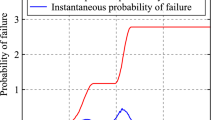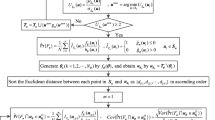Abstract
To learn the effect of interested distribution parameter, also the design variable of random input vector, on time-dependent failure probability, and to decouple time-dependent reliability-based design optimization (T-RBDO), estimating time-dependent failure probability function (T-FPF), a relation of time-dependent failure probability varying with the distribution parameter in interested design region, is necessary. However, estimating T-FPF is time-consuming and a challenge at present. Thus, this paper proposes a novel single-loop meta-model importance sampling with adaptive Kriging model (SL-Meta-IS-AK) to estimate T-FPF efficiently. In SL-Meta-IS-AK, for estimating the T-FPF by single-loop simulation, an optimal importance sampling probability density function (IS-PDF), which can envelope the interested distribution parameter region and be free of the distribution parameter, is constructed by an integral operation. After the Kriging model is adaptively constructed for time-dependent performance function to approach optimal IS-PDF for T-FPF by quasi-optimal one, a simple sampling strategy is designed to extract the samples of quasi-optimal IS-PDF, and a time-dependent misclassification probability function is derived to update the Kriging model adaptively until it can accurately recognize the states of all extracted samples, on which the T-FPF at the whole interested distribution parameter region can be estimated as a byproduct. Due to the single-loop simulation aided by the IS-PDF covering the interested distribution parameter region but free of the distribution parameter, the efficiency of estimating T-FPF is improved by the proposed SL-Meta-IS-AK, which is verified by presented numerical and aviation engineering examples including a wing structure and a turbine shaft structure.













Similar content being viewed by others
References
Au SK (2005) Reliability-based design sensitivity by efficient simulation. Comput Struct 83(14):1048–1061
Chaudhuri A, Kramer B, Willcox KE (2020) Information reuse for importance sampling in reliability-based design optimization. Reliab Eng Syst Saf 201:106853
Cheng K, Lu Z, Xiao S, Zhang X, Oladyshkin S, Nowak W (2021) Resampling method for reliability-based design optimization based on thermodynamic integration and parallel tempering. Mech Syst Signal Process 156:107630
Ching J, Hsieh YH (2007) Local estimation of failure probability function and its confidence interval with maximum entropy principle. Probab Eng Mech 22(1):39–49
Dang C, Wei P, Song J, Beer M (2021) Estimation of failure probability function under imprecise probabilities by active learning–augmented probabilistic integration. ASCE-ASME J Risk Uncertain Eng Syst, Part a: Civil Eng 7(4):04021054
Dubourg V, Sudret B, Deheeger F (2013) Metamodel-based importance sampling for structural reliability analysis. Probab Eng Mech 33:47–57
Echard B, Gayton N, Lemaire M (2011) AK-MCS: an active learning reliability method combining Kriging and Monte Carlo simulation. Struct Saf 33(2):145–154
Enevoldsen I, Sørensen JD (1994) Reliability-based optimization in structural engineering. Struct Saf 15(3):169–196
Feng K, Lu Z, Ling C, Yun W (2019) Efficient computational method based on AK-MCS and Bayes formula for time-dependent failure probability function. Struct Multidisc Optim 60(4):1373–1388
Gasser M, Schuëller GI (1997) Reliability-based optimization of structural systems. Math Methods Oper Res 46(3):287–307
Hu Z, Du X (2015) Mixed efficient global optimization for time-dependent reliability analysis. J Mech Des 137(5):051401
Hu Z, Mahadevan S (2016) A single-loop kriging surrogate modeling for time-dependent reliability analysis. J Mech Des 138(6):061406
Huang X, Zhang Y (2010) Reliability sensitivity analysis for rack-and-pinion steering linkages. J Mech Des 132(7):071012
Huang SP, Quek ST, Phoon K (2001) Convergence study of the truncated Karhunen-Loeve expansion for simulation of stochastic processes. Int J Numer Meth Eng 52(9):1029–1043
Jensen HA (2005) Structural optimization of linear dynamical systems under stochastic excitation: a moving reliability database approach. Comput Methods Appl Mech Eng 194(12–16):1757–1778
Jiang C, Fang T, Wang ZX, Wei XP, Huang ZL (2017) A general solution framework for time-variant reliability based design optimization. Comput Methods Appl Mech Eng 323:330–352
Li CC, Der Kiureghian A (1993) Optimal discretization of random fields. J Eng Mech 119(6):1136–1154
Li X, Zhang W, He L (2020) Bayes theorem–based and copula-based estimation for failure probability function. Struct Multidisc Optim 62(1):131–145
Ling C, Lu Z, Zhu X (2019) Efficient methods by active learning Kriging coupled with variance reduction based sampling methods for time-dependent failure probability. Reliab Eng Syst Saf 188:23–35
Ling C, Lu Z, Zhang X (2020) An efficient method based on AK-MCS for estimating failure probability function. Reliab Eng Syst Saf 201:106975
Shi Y, Lu Z, Huang Z (2020) Time-dependent reliability-based design optimization with probabilistic and interval uncertainties. Appl Math Model 80:268–289
Stone M (1974) Cross-validatory choice and assessment of statistical predictions. J Roy Stat Soc: Ser B (methodol) 36(2):111–147
Wang Z, Chen W (2016) Time-variant reliability assessment through equivalent stochastic process transformation. Reliab Eng Syst Saf 152:166–175
Wang Z, Wang P (2015) A double-loop adaptive sampling approach for sensitivity-free dynamic reliability analysis. Reliab Eng Syst Saf 142:346–356
Yu S, Wang Z (2019) A general decoupling approach for time-and space-variant system reliability-based design optimization. Comput Methods Appl Mech Eng 357:112608
Yuan X (2013) Local estimation of failure probability function by weighted approach. Probab Eng Mech 34:1–11
Yuan X, Zheng Z, Zhang B (2020) Augmented line sampling for approximation of failure probability function in reliability-based analysis. Appl Math Model 80:895–910
Zhang J, Ellingwood B (1994) Orthogonal series expansions of random fields in reliability analysis. J Eng Mech 120(12):2660–2677
Zhang H, Song L, Bai G (2022a) Moving-zone renewal strategy combining adaptive Kriging and truncated importance sampling for rare event analysis. Struct Multidisc Optim 65(10):285
Zhang H, Song L, Bai G (2022b) Active extremum Kriging-based multi-level linkage reliability analysis and its application in aeroengine mechanism systems. Aerosp Sci Technol 131:107968
Zhang H, Song L, Bai G (2023) Active Kriging-based adaptive importance sampling for reliability and sensitivity analyses of stator blade regulator. Comput Model Eng Sci 134(3):1871–1897
Zhu X, Lu Z, Yun W (2020) An efficient method for estimating failure probability of the structure with multiple implicit failure domains by combining meta-IS with IS-AK. Reliab Eng Syst Saf 193:106644
Acknowledgements
The support by the National Natural Science Foundation of China (Project 12272300) is gratefully acknowledged.
Author information
Authors and Affiliations
Corresponding author
Ethics declarations
Conflict of interest
We declare that we do not have any commercial or associative interest that represents a conflict of interest in connection with the work submitted.
Replication of results
The original codes of the numerical example in Sect. 4 are available in the supplementary materials.
Additional information
Responsible Editor: Byeng D Youn
Publisher's Note
Springer Nature remains neutral with regard to jurisdictional claims in published maps and institutional affiliations.
Supplementary Information
Below is the link to the electronic supplementary material.
Appendices
Appendix 1: Kriging surrogate model
Select training set \({\varvec{T}} = \{ ({\varvec{x}}_{1} ,g({\varvec{x}}_{1} )),({\varvec{x}}_{2} ,g({\varvec{x}}_{2} )), \cdots ,({\varvec{x}}_{{N_{t} }} ,g({\varvec{x}}_{{N_{t} }} ))\}^{T}\) (\(N_{t}\) is the size of the training set) by a design of experiment (DOE) for performance function \(Y = g({\varvec{x}})\). Then, the Kriging model \(g_{K} ({\varvec{x}})\) of \(g({\varvec{x}})\) can be established by Kriging toolbox as:
where \({\varvec{f}}^{T} ({\varvec{x}}){\varvec{\beta}}\) is the regression model. \({\varvec{f}}({\varvec{x}}) = [f_{1} ({\varvec{x}}),f_{2} ({\varvec{x}}), \cdots ,f_{n} ({\varvec{x}})]^{T}\) is the basis vector of the regression function, and \(n\) represents the number of basis functions. \({\varvec{\beta}} = (\beta_{1} ,\beta_{2} , \cdots ,\beta_{n} )^{T}\) is the coefficient vector of the regression function. \(Z({\varvec{x}})\) is a Gaussian process with a mean of zero and a standard deviation of \(\sigma\). Its covariance matrix is:
where \(R({\varvec{x}}_{i} ,{\varvec{x}}_{j} )\) is the correlation function of any two sample points, and it has many expressions. In this paper, the following Gaussian form is adopted,
where \(x_{i}^{(k)}\) represents the \(k\)-dimensional component of the sample \({\varvec{x}}_{i}\). \({\varvec{\xi}} = (\xi_{1} ,\xi_{2} , \cdots ,\xi_{n} )^{T}\) is an unknown correlation parameter vector, and it can be obtained by maximum likelihood estimation as follows,
The regression coefficient vector \({\varvec{\beta}}\) and the variance \(\sigma^{2}\) of the Gaussian process can be obtained from the training points shown in Eqs. (46) and (47), respectively,
where \({\varvec{F}}\) is an \(N_{t} \times n\) regression matrix shown as follows:
\({\varvec{R}}\) is an \(N_{t} \times N_{t}\) correlation matrix in Eq. (49).
According to the principle of Kriging model, the predicted value at any untried point \({\varvec{x}}\) follows the Gaussian distribution with a mean of \(\hat{\mu }_{{g_{K} }} ({\varvec{x}})\) and a variance of \(\hat{\sigma }_{{g_{K} }}^{2} ({\varvec{x}})\); namely, \(\hat{g}({\varvec{x}}) \sim N\left( {\hat{\mu }_{{g_{K} }} ({\varvec{x}}),\hat{\sigma }_{{g_{K} }}^{2} ({\varvec{x}})} \right)\). \(\hat{\mu }_{{g_{K} }} ({\varvec{x}})\) and \(\hat{\sigma }_{{g_{K} }}^{2} ({\varvec{x}})\) are shown in Eqs. (50) and (51), respectively,
where \({\varvec{r}}({\varvec{x}})\) is the correlation coefficient vector between training sample and predicted points. \({\varvec{r}}({\varvec{x}})\) and \({\varvec{u}}({\varvec{x}})\) are shown in Eqs. (52) and (53), respectively.
Appendix 2: the proof of the importance samples
Suppose that the cumulative distribution function of the random vector \({\varvec{X}}\) is \(F_{{\varvec{X}}} ({\varvec{a}}) = P\{ X_{1} \le a_{1} ,X_{2} \le a_{2} , \cdots ,X_{n} \le a_{n} \} = P\{ {\varvec{X}} < {\varvec{a}}\}\). Then,
Under the condition of the acceptance domain of \(\Omega = \{ p - c\pi_{{F_{t} }} (\varvec{x|\theta }) \le 0\}\), where \(p\sim U[0,1]\), \(\varvec{x\sim }f_{{\varvec{X}}} (\varvec{x|\theta })\) and \(c\pi_{{F_{t} }} (\varvec{x|\theta }) \le 1\), the conditional CDF \(F_{{{\varvec{X}}|\Omega }} ({\varvec{a}}) = P\{ {\varvec{X}} < {\varvec{a}}|p < c\pi_{{F_{t} }} (\varvec{x|\theta })\}\) of vector \({\varvec{X}}\) on \(\Omega\) can be estimated as follows:
where \(f_{P} (p) = \left\{ \begin{gathered} 1, \, 0 \le p \le 1 \hfill \\ 0, {\text{else}} \hfill \\ \end{gathered} \right.\) is PDF of the standard uniform random variable \(p\).
According to Eqs. (54) and (55), it is obvious that \(F_{{\varvec{X}}}^{{\tilde{h}}} ({\varvec{a}}) = F_{{{\varvec{X}}|\Omega }}^{f} ({\varvec{a}})\). Therefore, the samples generated from the acceptance domain \(\Omega\) are those generated from \(\hat{h}_{{\varvec{X}}} (\varvec{x|\theta })\).
Rights and permissions
Springer Nature or its licensor (e.g. a society or other partner) holds exclusive rights to this article under a publishing agreement with the author(s) or other rightsholder(s); author self-archiving of the accepted manuscript version of this article is solely governed by the terms of such publishing agreement and applicable law.
About this article
Cite this article
Lu, Y., Lu, Z. A novel single-loop meta-model importance sampling with adaptive Kriging for time-dependent failure probability function. Struct Multidisc Optim 66, 79 (2023). https://doi.org/10.1007/s00158-023-03523-x
Received:
Revised:
Accepted:
Published:
DOI: https://doi.org/10.1007/s00158-023-03523-x




